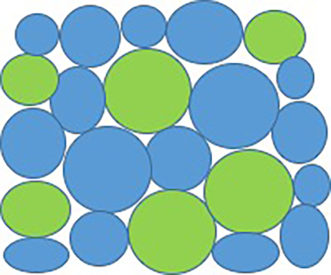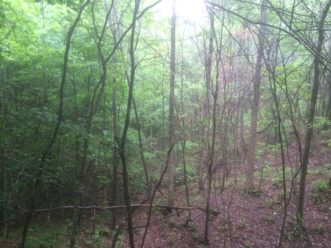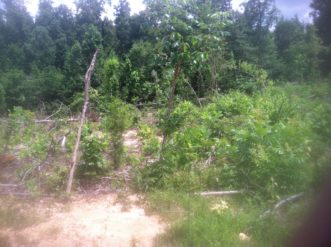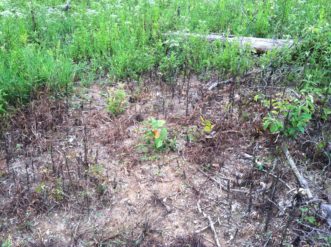Importance of Herbicide in Hardwoods
Herbicide applications can be implemented throughout the life of a hardwood forest to improve stand attributes. Benefits of herbicide applications may include increased water and nutrient availability, improved seedling survival and growth, shortened rotation length, control of less desirable species, and improved competitive status. For hardwood plantations that have just been planted, chemical release can improve early seedling survival and growth.1,2,3 Similarly, early pre-commercial thinnings, using herbicides, within recent clearcuts can also promote survival, growth, and increase the competitive stance of preferred hardwoods.4,5 As stands begin to reach crown closure, crop tree release treatments can be used to improve crown development, diameter growth, and volume production of individual stems.6,7 Some mid-rotation hardwood stands can also benefit from timber stand improvement utilizing herbicides to improve the growth of preferred growing stock.8,9 And lastly, deadening or removal of less desirable stems in midstory and understory canopy positions in older mature stands, especially those dominated by oak, will improve oak seedling growth, which may promote oak regeneration success.10,11,12
Pre-treatment Planning for Site Conditions
Competitor Plant Species Identification
An assessment of vegetation within the targeted treatment area should be conducted in advance of chemical application. Plant identification smartphone apps that can aid in proper recognition of plant species are available. Once a list of competitor plants is created, the selection of the proper herbicide to adequately control these plants can be made. For instance, in areas where leguminous species are the primary vegetation to be treated, some herbicides such as imazapyr will provide inadequate control. Another herbicide such as clopyralid or a mixture of herbicides would be more effective in this situation. Herbicide labels provide a listing of plant species that the active ingredient sufficiently controls. The label also provides information on mixing compatibility with other herbicides to improve treatment efficacy. Managers should always thoroughly read pesticide labels before and during the planning stage to ensure both legal requirements and management objectives are fulfilled.
Soil Type
Soil texture, soil drainage, and soil pH can impact the effectiveness of a given herbicide. Fine-textured soils such as clays typically require a higher application rate (amount of active ingredient used per label recommendations) compared to coarse-textured soils such as sand. Poorly drained soils that may experience more prolonged periods of standing surface water may also limit the type of herbicide that can be applied. High pH or alkaline soils, along with water pH (alkaline), can significantly diminish herbicide effectiveness as well. The product label will indicate limitations or variations in usage for each pesticide.
Sensitive Areas
Sensitive areas may include wetlands, locales with known presence of endangered/threatened species, steep slopes, agricultural cropland, and others. Pesticide usage in such areas may either be prohibited or restricted. Contact the Clemson Regulatory Services Department of Pesticide Regulation for any questions that may involve a potentially sensitive area and chemical applications before initiating herbicide treatment.
Pre-treatment Planning for Environmental Conditions
Weather conditions can severely impact herbicide effectiveness and influence detrimental effects resulting from poorly timed applications. In general, applications should be avoided during extreme weather conditions, including drought, excessively high and low temperatures, heavy rainfall, and high winds. Uptake and translocation of active ingredients by plants are diminished during droughty periods when plants are not actively growing. Volatilization of herbicide can occur during high-temperature days and may lead to injury/mortality both within the treatment and adjacent areas with non-target plant species. It is best to apply herbicides when the temperature is less than 85° F, and humidity is above 20% (figure 1). Similar damage may also be associated with herbicide sprays conducted in high winds. Herbicide drift may occur when fine droplets of spray move outside of the targeted spray area. Using nozzles that create a larger droplet size can aid in minimizing drift. However, it is best to perform applications when temperature, humidity, and wind are most favorable such as in the morning. Also, avoid spraying when inversion layers are present as spray droplets can remain suspended in the air for long periods and increase drift potential.

Figure 1. Herbicide application should only occur when temperature and humidity conditions do not favor volatilization. Image credit: Stephen Peairs, Clemson University.
Application Methods at Varying Stages of Stand Development
Seedling Release Treatments
Chemical release of planted hardwoods is typically required on sites that have been artificially regenerated. Release treatments have been shown to increase first-year survival and growth when vegetative competition with planted seedlings is reduced. The herbicide selected for use depends on the plant community present at the site. Plant community composition is important because some herbicides may target herbaceous flowering plants but have limited impact on grasses. Some formulations may offer better control on grasses but have a limited spectrum of control for other weed species. Other herbicides may control both plant types but may also injure or kill planted seedlings. In any situation, the optimal outcome is to create bare ground conditions (figure 2 and figure 3) or eliminate as much plant competition as possible. A note of caution, when applying herbicides to control vegetation directly beside the crop tree, be careful to avoid transference of active ingredient through the root zone. Spot spraying woody plants with the appropriate herbicide to kill targeted plants may help avoid unwanted uptake of active ingredients that may injure or reduce the growth of crop seedlings. Table 1 lists the herbicides commonly used to promote early hardwood afforestation efforts and areas that recently (in the latter half of the previous growing season) received broadcast site preparation spraying.
Table 1. Forestry herbicide applications for herbaceous seedling release.
| Chemical | Clethodim | Fluaziflop-P-butyl | Sulfometuron methyl | Clopyralid |
| HERBICIDE TRADE NAMES |
Select 2EC®, Select Max® | Fusilade DX® | Oust XP®, SFM 75®, Spyder® | Transline®, Clopyralid 3® |
| APPLICATION TIMING |
grass height approx. 6 inches for tall or 3 inches for small grass (spring) |
2 applications
(30 days apart) |
late winter/early spring (March-prior to bud swell) |
late May-June (prior to hardening of leaves) |
| APPLICATION RATES (PER ACRE) |
16 ounces | 8 ounces per application | 1.5-2.0 ounces | 21 ounces |
| TARGETED WEED SPECIES |
perennial grasses | perennial grasses (except broomsedge, fescue) |
broadleaf forbs fescue |
broadleaf forbs, eastern redbud, locust, mimosa, kudzu |
| COST PER ACRE | <$15 | $20-$30 | <$15 | $20-$30 |
| ADJUSTMENTS | rate and timing vary by grass speciessplit applications (improved effectiveness)add ¼ percent non-ionic surfactant |
use maximum rate of 24 ounces if one-time application
rate and timing vary add ¼ percent non-ionic surfactant |
use ½ rate if soil pH is 6.2-6.5
avoid use if pH at or above 7.0 soil residual activity may last for a few months |
avoid early growing season applicationsadd ¼ percent non-ionic surfactant |
Note: Sulfometuron methyl will yield longer durations of control pending soil texture on the site. Finer particles such as clays will experience longer suppression of herbaceous weeds. Sandier soils will have a shorter duration of control. Avoid tank mixing of sulfometuron methyl and the grass selective herbicides as mixing will reduce the effectiveness of weed control. If both forbs and grasses form significant components of plant competition, two individual applications applied 30 days or more apart may be necessary to reach acceptable weed reduction levels.
Additional Note: Glyphosate can be utilized as a direct foliar spray (5% solution) to control individual woody plants around the preferred crop tree but should not be utilized for broadcast spray applications. Potential injurious results were proposed when applied as broadcast or radial sprays around preferred seedlings in previous research. The herbicide is suspected to have reduced growth of released trees though mortality was not observed.15
Weeding Operations
Weeding practices can be applied during the initial establishment period of a stand following a disturbance such as timber harvesting. Treatments involve managing species composition by directly reducing individual woody stems, directly increasing resources available for potential crop trees. Preferred crop species are shade-intolerant species such as yellow-poplar (Liriodendron tulipifera), oak (Quercus sp.), black cherry (Prunus serotina), and ash (Fraxinus sp.). Less desirable crop species such as sweetgum (Liquidambar styraciflua), maples (Acer sp.), American beech (Fagus grandifolia), sassafras (Sassafras albidum), and others directly compete with preferred species for available growing space. Weeding of less desirable species will promote enhanced growth of desirable species and could potentially improve the future crown position of crop trees. Accelerated growth rates improve the competitive status of reproduction and may be necessary for a given tree to establish dominance in the future stand. The probability of any given stem forming a dominant or codominant position in the developing stand is highly dependent on size (at least four feet in height) and status (advanced or new germinant) of said stem at the point of disturbance.13 Weeding reduces overall stocking on a given site and improves growing conditions for preferred species.
Weeding operations are optimal when conducted either in spring following a disturbance or shortly after timber harvesting completion during the first half of the active growing season. In either case, herbicide treatments are applied at the point where natural hardwood regeneration (e.g., crop trees) is observable. Early spring applications enable seedlings to capture a higher amount of nutrients and water due to less competition from weedy species.
Land managers should designate preferred seedlings as crop trees before or during treatment. Marking stems may also prove useful in follow up evaluations to determine survival and treatment effectiveness. A minimum of one hundred crop trees per acre is advised for weeding. Direct foliar sprays of adjacent competing, less desirable woody stems in a radius of five to ten feet may then be executed to deaden the targeted woody reproduction. A ground crew using backpack sprayers (e.g., SoloTM, Chapin®, or other brands) can accomplish this task. Non-soil active herbicides such as glyphosate or triclopyr are preferred to reduce potential uptake by crop seedlings (table 2). Solution mix rates between 2% to 3% herbicide (triclopyr and glyphosate, respectively) will yield acceptable control of targeted stems. Applicators should refer to the guidelines provided on the herbicide label. Use extreme caution to avoid contact of crop tree foliage with herbicides. The use of a covering (stovepipe or other cylindrical apparatus) placed over the top of the crop trees can be used to shield favored seedlings.
Table 2. Forestry herbicide applications for cut stem and basal bark treatments.
Chemical |
Herbicide Trade Names | Application Method | Solution Rate | Targeted Weed Species | Application Rate |
| Clopyralid | Transline®, Clopyralid 3® |
cut stem (hack and squirt) cut stump |
50% herbicide / 50% water same |
woody legumes (kudzu, redbud, locust, mimosa, wisteria) |
1 ml of solution per cut; 3-4 inches between cut centers completely wet outer cut surface (cambium) of stump |
| Imazapyr | Arsenal AC®, Polaris AC®, imazapyr 4 SL® |
cut stem cut stump |
20% herbicide / 80% water 5% herbicide / 95% water |
most hardwoods (except legumes) |
1 ml of solution per cut; 1 cut per 3-inch increase in diameter completely wet outer cut surface (cambium) of stump |
| Picloram | Tordon RTU®, Triumph RTU®. (RTU – ready to use) |
cut stem cut stump |
undiluted undiluted |
limited hardwoods, cedar | 1 ml per cut; no more than 2-3 inches between cuts completely wet outer cut surface (cambium) of stump |
| Picloram | Tordon 101®, Gunslinger P+D® | cut stem cut stump |
50% herbicide / 50% water same |
limited hardwoods, cedar, pine | 1 ml of solution per cut; 2-3 inches between cut edges completely wet outer cut surface (cambium) of stump |
| Triclopyr | Garlon 3A®, Tryclopyr 3®, Trycera® |
cut stem cut stump |
50% herbicide / 50% water same |
most hardwoods, pine (weak on sourwood) | 1 ml of solution per cut; 3-4 inches between cut centers completely wet outer cut surface (cambium) of stump |
| Triclopyr | Garlon 4®, triclopyr 4®, trycera® |
basal bark | 20% herbicide / 10% penetrant / 70% basal oil, diesel fuel, or other diluent |
stems under 5 inches in diameter |
streamline application: wet one half of stem from ground level to 12-15 inches above ground |
| Glyphosate | Accord SP®, Cornerstone®, any with 41% active ingredient |
cut stem cut stump |
50%-100% herbicide / remainder in water same |
most hardwoods, pine | apply herbicide in a continuous frill around stem apply on entire cambium |
Note: Cut stem applications are most efficient in the fall season but effective from July – January. Avoid making applications during or near freezing temperature conditions. Costs per acre range due to treated stem density. Bolded font represents cut stump information.
Timber Stand Improvement (TSI)

Figure 4. Crop tree release visualization from above in a small poletimber or large sapling stand. “Green” trees are representative of crop trees. “blue” trees are to be targeted for deadening. All crop trees are released on at least three or all four sides, which enable for crown expansion room. Image credit: Stephen Peairs, Clemson University.
Herbicide usage in mid-rotation stands can improve growing conditions and make the management of preferred growing stock (crop trees) easier. Stands may be classified as being mid-rotation when they enter stem exclusion following crown closure. All stems are now competing for available growing resources. Some trees will form dominant or codominant crowns, whereas other stem crowns will become either suppressed or intermediate. Growth differences between these two groups are significant, with larger crowned trees being of higher vigor and annual growth. Smaller crowned stems will either experience natural mortality or have diminished growth rates. Timber stand improvement attempts to promote growth by accelerating this natural process. Instead of allowing natural mortality to occur, managers induce mortality by targeting stems for deadening or removal (figure 4). Typically, trees adjacent to preferred crop trees are deadened or removed. Less desirable species or poorly formed trees are usually selected to receive treatments. The desired result of TSI is improved growth or volume production caused by enhanced tree vigor and enriched nutrient and water availability. For more developed stands, a minimum of thirty-six or more poletimber sized trees (4″ to 8″ diameter at breast height) per acre should be chemically or mechanically released.14. In younger sapling sized stands, upwards of sixty stems plus can be released if desired.
Midstory/Understory Control for Natural Regeneration

Figure 5. Chemically treated midstory control (left) compared to the untreated area (right). Increased sunlight is notably augmented, which should promote regeneration efforts. Photo credit: Stephen Peairs, Clemson University.
Many mature hardwood stands have an understory canopy dominated by shade-tolerant species including American beech, black gum (Nyssa sylvatica), maples, eastern hophornbeam (Ostrya virginiana), hickory (Carya sp.), sourwood (Oxydendron arboretum), sassafras, etc. Hardwood forestland that has experienced timber harvesting (thinning, diameter-limit harvesting, high-grading, or other forms of uneven-aged management) typically possess a substantial component of shade-tolerant saplings and large seedling reproduction. Stands that have never experienced any type of disturbance, such as timber harvesting or severe storms (straight-line winds, tornadoes), will have less of these stems. Over-mature stands (greater than 100 years of age) have likely experienced some natural overstory mortality that can also enable shade-tolerant species to persist and grow. In any of these situations, these stems provide enough canopy coverage to substantially increase shade on the forest floor. Understory light conditions of less than 5% sunlight penetration are common in such stands.10,12 The lack of sunlight penetration inhibits the development of oak and other preferred shade-intolerant species. This also increases advanced shade-tolerant reproduction that has a competitive advantage over newly established seedlings, increasing the likelihood of shade-tolerant species dominating the future stand’s species composition following disturbance.
Some form of silvicultural treatment should be conducted to eliminate or reduce the prevalence of shade-tolerant species in lesser canopy positions (figure 5). This practice serves to increase sunlight penetration and eliminate coppice sprouting of less desirable, shade-tolerant species after treatment. The most effective method for achieving midstory and understory control is through herbicide applications. Forms of application for larger stems may include stem injection (hack and squirt) and basal bark treatment. Application for seedlings includes directed foliar sprays.
Conclusion
Herbicide applications can mean the difference between failure and success with regard to hardwood regeneration efforts. Less desirable plant species may dominate the canopy if chemicals are not used to promote the health and growth of preferred growing stock (oak in particular) and to accelerate seedling growth. The spread of non-native, invasive plants may also occur without herbicide use. Judicious use of herbicides can promote forest management with negligible adverse effects on the environment when practitioners adhere to label requirements. In any stage of development, most hardwood stands can be improved through pest plant management.
References
- Ezell AW, Hodges JD. Herbaceous weed control improves the survival of planted shumard oak seedlings. Proceedings of the eleventh biennial southern silvicultural research conference. 2002. Asheville (NC): U.S. Department of Agriculture, Forest Service, Southern Research Station. p. 268–270.
- Ezell AW, Yeiser JL, Nelson LR. Survival of planted oak seedlings is improved by herbaceous weed control. Weed Technology. 2007;21(1):175–178. doi:10.1614/wt-06-114.1.
- Self AB, Ezell AW, Moree JL, Thornton RO. Effect of directed spray glyphosate applications on survival and growth of planted oaks after three growing seasons. Proceedings of the fifteenth biennial southern silvicultural conference. 2013. Asheville (NC): U.S. Department of Agriculture, Forest Service, Southern Research Station. USDA general technical report SRS-175. p. 295–298.
- Thompson JF Jr, Nix LE. Early release of naturally-regenerated cherrybark and shumard oak seedlings with herbicides. Proceedings of the seventh biennial southern silvicultural research conference. 1992. Asheville (NC): U.S. Department of Agriculture, Forest Service, Southern Research Station. General Technical Report SO-93. p. 445–452.
- Nix LE. Herbicide release of 4 year old, naturally regenerated bottomland oaks – 10 year results. Proceedings of the twelfth biennial southern silvicultural research conference. 2004. Asheville (NC): U.S. Department of Agriculture, Forest Service, Southern Research Station. General Technical Report SRS-71. p. 520–523.
- Schuler TM. Crop tree release improves competitiveness of northern red oak growing in association with black cherry. Northern Journal of Applied Forestry. 2006;23(2):77-82.
- Ward JS. Intensity of precommercial crop tree release increases diameter growth and survival of upland oaks. Canadian Journal of Forest Research. 2009;39(1):118-130.
- Mitchell RJ, Dwyer JP, Musbach RA, Garrett HE, Cox GS, Kurtz WB. Crop tree release of a scarlet-black oak stand. Northern Journal of Applied Forestry. 1988;5(2):96-99.
- Schlesinger RC. Increased growth of released white oak poles continues through two decades. Journal of Forestry. 1978;76(11):726-727.
- Lhotka JM, Loewenstein EF. Effect of midstory removal on understory light availability and the 2-year response of underplanted cherrybark oak seedlings. Southern Journal of Applied Forestry. 2009;33(4):171-177.
- Lockhard BR, Hodges JD, Gardiner ES. Response of advance cherrybark oak reproduction to midstory removal and shoot clipping. Southern Journal of Applied Forestry. 2000;24(1):45-50.
- Parrott DL, Lhotka JM, Stringer JW, Dillaway DN. Seven-year effects of midstory removal on natural and underplanted oak reproduction. Northern Journal of Applied Forestry. 2012;29(4):182-90.
- Sander IL. Size of oak advance reproduction: key to growth following harvest cutting. 1972. St. Paul (MN): U.S. Dept. of Agriculture, Forest Service, North Central Forest Experiment Station. Research Paper NC-79.
- Mercker D. Crop tree release in precommercial hardwood stands. Knoxville (TN): University of Tennessee Extension; 2007. SP559.
- Peairs SE. Oak and yellow-poplar response to pre-commercial chemical applications after clearcutting a high-graded hardwood stand on the western highland rim of Tennessee [dissertation]. [Knoxville (TN)]: University of Tennessee; 2018.



